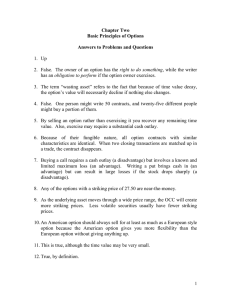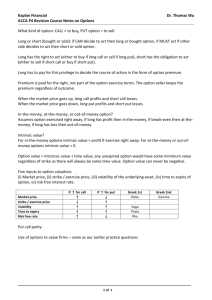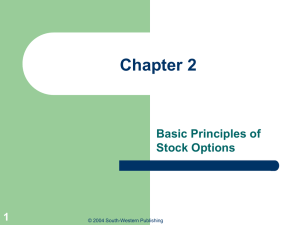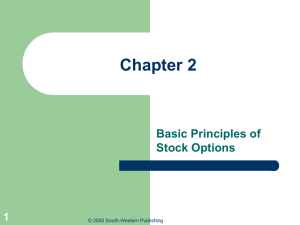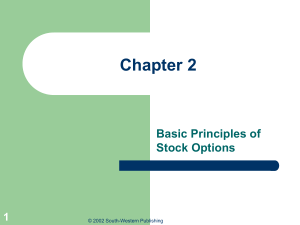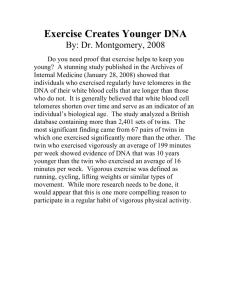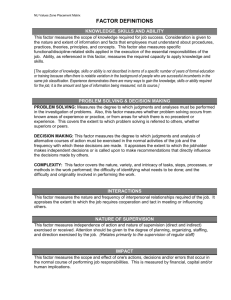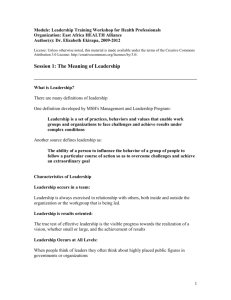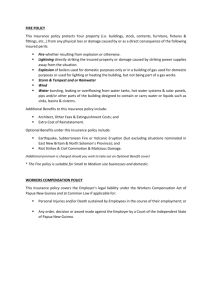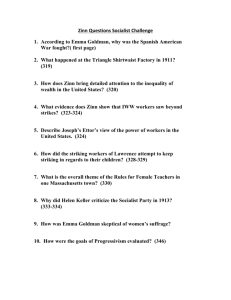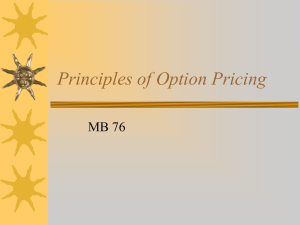Document
advertisement
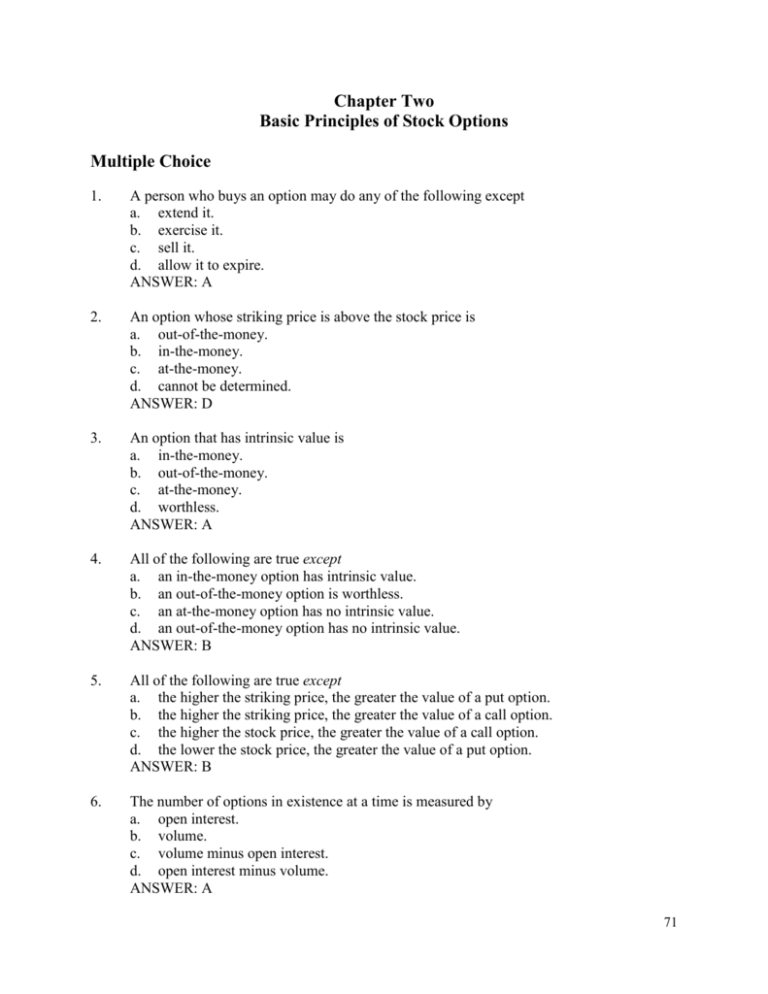
Chapter Two Basic Principles of Stock Options Multiple Choice 1. A person who buys an option may do any of the following except a. extend it. b. exercise it. c. sell it. d. allow it to expire. ANSWER: A 2. An option whose striking price is above the stock price is a. out-of-the-money. b. in-the-money. c. at-the-money. d. cannot be determined. ANSWER: D 3. An option that has intrinsic value is a. in-the-money. b. out-of-the-money. c. at-the-money. d. worthless. ANSWER: A 4. All of the following are true except a. an in-the-money option has intrinsic value. b. an out-of-the-money option is worthless. c. an at-the-money option has no intrinsic value. d. an out-of-the-money option has no intrinsic value. ANSWER: B 5. All of the following are true except a. the higher the striking price, the greater the value of a put option. b. the higher the striking price, the greater the value of a call option. c. the higher the stock price, the greater the value of a call option. d. the lower the stock price, the greater the value of a put option. ANSWER: B 6. The number of options in existence at a time is measured by a. open interest. b. volume. c. volume minus open interest. d. open interest minus volume. ANSWER: A 71 Chapter 2. Basic Principles of Stock Options 7. Which of the following is not possible? a. volume 110, open interest 100 b. volume 100, open interest 110 c. volume 0, open interest 100 d. volume 0, open interest – 100 ANSWER: D 8. The guarantor of option trades is the ______________. a. SEC b. OCC c. CFTC d. FDIC ANSWER: B 9. Options trade on all of the following except the _____________________. a. American Stock Exchange b. New York Stock Exchange c. Philadelphia Stock Exchange d. Pacific Stock Exchange ANSWER: B 10. The newest U.S. options exchange is the __________________. a. National Stock Exchange b. American Stock Exchange c. International Stock Exchange d. Global Stock Exchange ANSWER: C 11. A LEAP is a(n) a. commodity option. b. gold or silver option. c. long-term option. d. option with a high striking price. ANSWER: C 12. An option that is not fungible is most likely a. an over-the-counter option. b. traded at the CBOE. c. listed. d. about to expire. ANSWER: A 72 Chapter 2. Basic Principles of Stock Options 13. Option striking prices are normally at a. $2 intervals. b. $5 intervals. c. $7 intervals. d. $10 intervals. ANSWER: B 14. An option whose ticker ends in CH is a a. March 25 call. b. March 25 put. c. March 40 call. d. March 40 put. ANSWER: C 15. An option whose ticker symbol ends in OC is a a. March 15 call. b. March 15 put. c. March 25 call. d. March 25 put. ANSWER: B 16. An exchange employee who makes sure small public orders get filled quickly is the a. Order Book Official. b. Ombudsman. c. Trade Checker. d. Flow Manager. ANSWER: A 17. Options are not normally a. exercised early. b. exercised after expiration. c. exercised when out-of-the-money. d. All of the above ANSWER: D 18. In a profit and loss diagram, a. the bend occurs at the stock price. b. the bend occurs at the striking price. c. there is a bend at both the stock price and the striking price. d. the bend occurs at the maximum profit. ANSWER: B 73 Chapter 2. Basic Principles of Stock Options 19. If you write a naked call, a. the maximum profit is unlimited. b. the maximum loss is unlimited. c. the maximum loss equals the premium. d. the maximum loss equals the stock price minus the striking price. ANSWER: B 20. If you write a put option, a. the maximum profit is unlimited. b. the maximum loss is unlimited. c. the maximum gain equals the premium. d. the maximum gain equals the stock price minus the striking price. ANSWER: C 21. OEX is symbolic for a. order expiration. b. the S&P 100 stock index options. c. order execution. d. the S&P 500 futures contract. ANSWER: B 22. LEAPS are issued with durations of all of the following except __________. a. 1 year b. 2 years c. 3 years d. 10 years ANSWER: D True/False 1. A call option gives you the right to buy. ANSWER: T 2. A put option is a promise to sell. ANSWER: F 3. Options can be created, and they can be destroyed. ANSWER: T 4. Selling an option as an opening transaction is called writing the option. ANSWER: T 5. Listed options are fungible. ANSWER: T 74 Chapter 2. Basic Principles of Stock Options 6. Options expire on the second Friday of the expiration month. ANSWER: F 7. At the CBOE, options trade via the specialist system. ANSWER: F 8. A European option may only be exercised at expiration. ANSWER: T 9. An American call option should normally not be exercised until just before expiration. ANSWER: T 10. A put writer may have to involuntarily buy shares if the put holder decides to exercise. ANSWER: T 11. An option that is in-the-money must have intrinsic value. ANSWER: T 12. Buying a call is the same as writing a put. ANSWER: F 13. The value of a perpetual European put option is zero. ANSWER: T Short Answer/Problem 1. Listed below are four basic option positions. Two of these are generally bearish and two are bullish. Put them in the correct column. buy a call write a call buy a put BEARISH _______________ _______________ write a put BULLISH _______________ _______________ ANSWER: Writing a call and buying a put are bearish; buying a call and writing a put are bullish. 2. Explain the difference between an American option and a European option. ANSWER: American options may be exercised anytime; European options may only be exercised at expiration. 75
